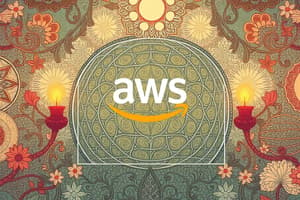Podcast
Questions and Answers
Match the following programming languages with their primary usage:
Match the following programming languages with their primary usage:
Python = General-purpose programming Ruby = Network programming with net/http library Java = Network programming with java.net package JavaScript = Client-side scripting for web applications
Match the Linux distributions with their descriptions:
Match the Linux distributions with their descriptions:
Ubuntu = Popular choice for desktop users Fedora = Focused on innovation and new technologies CentOS = Preferred for server environments Debian = Known for its stability and security features
Match the following cloud computing terms with their definitions:
Match the following cloud computing terms with their definitions:
IaaS (Infrastructure as a Service) = Cloud service providing virtualized computing resources PaaS (Platform as a Service) = Cloud service offering a platform for application development SaaS (Software as a Service) = Cloud service delivering software applications over the internet Public Cloud = Cloud infrastructure shared by multiple organizations
Match the following AWS services with their descriptions:
Match the following AWS services with their descriptions:
Match the SQL statements with their functions:
Match the SQL statements with their functions:
Match the following cloud computing benefits with their descriptions:
Match the following cloud computing benefits with their descriptions:
Match the following AWS services with their descriptions:
Match the following AWS services with their descriptions:
Match the following concepts with their definitions in network programming:
Match the following concepts with their definitions in network programming:
Match the following Linux commands with their descriptions:
Match the following Linux commands with their descriptions:
Match the following SQL statements with their functions:
Match the following SQL statements with their functions:
Flashcards are hidden until you start studying
Study Notes
Multiple Topics
Cloud Computing Basics
Cloud computing refers to the delivery of computing resources over the internet, enabling users to access shared pools of computers, servers, databases, and applications without having to manage their own hardware or infrastructure. Cloud computing offers several benefits such as cost savings, flexibility, scalability, and ease of deployment.
AWS Fundamentals
Amazon Web Services (AWS) is one of the leading cloud service providers that offers various services such as compute, storage, database, and analytics. AWS provides infrastructure services like Amazon Elastic Compute Cloud (EC2), which enables users to rent virtual computers on which they can run their own applications. They also offer machine learning services like Amazon SageMaker, which allows users to build, train, and deploy machine learning models quickly. AWS uses the concept of infrastructure as code (IaC) using tools like AWS Cloud Development Kit (CDK) that allow developers to model their applications in programming languages instead of domain-specific ones, leading to easier application deployment and maintenance. They also provide services through APIs such as AWS Management Console and AWS Command Line Interface (CLI) for managing resources programmatically.
Network Programming Language Basics
Network programming involves writing software that communicates over a network, either between different machines or within a single system. Programming languages play a crucial role in network programming due to their expressiveness and ability to handle complex tasks efficiently. Some popular programming languages for network programming include Python with libraries like sockets, requests, and Beautiful Soup; Ruby with its net/http library; and Java with its java.net package. These language choices depend on factors such as performance requirements, ease of use, and compatibility with existing codebase.
Linux Basics
Linux is an open-source operating system based on Unix principles. It's widely used in servers, supercomputers, and embedded devices. The main reason behind its popularity is its stability, flexibility, and security features. Linux distributions are freely available, and their source code can be modified by developers worldwide, making them suitable for both personal and professional use. Some common Linux distributions include Ubuntu, Fedora, CentOS, Debian, and Arch Linux.
SQL Basics
Structured Query Language (SQL) is a standard language for managing relational databases. It was developed by IBM in the early 1970s. Today, SQL is supported by most relational database management systems (RDBMS). SQL consists of two parts: declarative statements called SELECT, INSERT, UPDATE, and DELETE statements, and procedural statements called CREATE PROCEDURE and CALL statements. SQL is primarily used for manipulating and retrieving data from relational databases, including performing queries, updating data, defining views, and creating stored procedures.
Studying That Suits You
Use AI to generate personalized quizzes and flashcards to suit your learning preferences.




